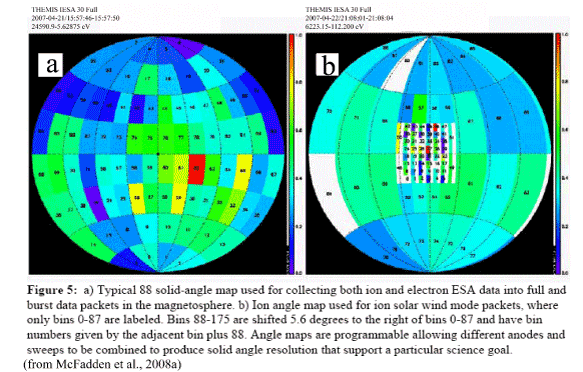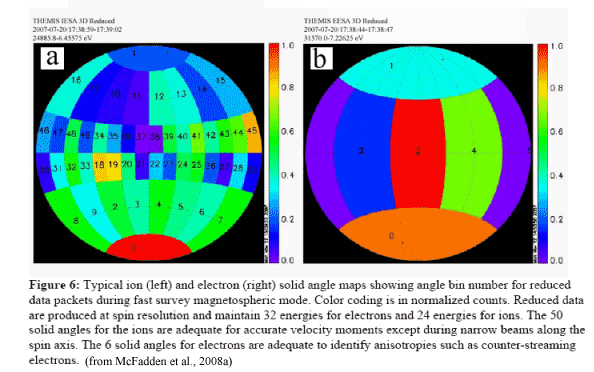Instruments
ESA Modes and Data Products (from McFadden et al., 2008a)
ESA data are collected and formatted by the ETC board in the IDPU into seven data products: two full packets, two burst packets, two reduced packets, and moment packets. Each sensor has separate packets, except for moment packets which are made by combining data from both ESAs and the Solid State Telescopes (SSTs) (Larson et al., 2008). The format of each data product is programmable and may change with time depending on the "Spacecraft-Mode," the location within the magnetosphere, or with the development of new "instrument-modes" that can be uploaded to the satellites. Below we describe data products generated by the nominal "magnetospheric mode" used for the majority of the first nine months of the mission, and the "solar wind" mode which can be used to resolve the cold solar wind ions.
"Full packets" are a low-time-resolution data product useful for large-scale surveys of THEMIS data. They generally maintain the "full" 32 energies sampled, and have an 88 solid-angle map as illustrated in Figure 5a. Full distribution data are 1-spin snapshots of the plasma with a measurement cadence of either 32 spins (in "Fast-Survey Spacecraft Mode") or 128 spins ("Slow-Survey Spacecraft Mode"). These high energy-angle resolution measurements are the primary data product used for the in-flight calibration effort described below. Full packets are used to generate summary plots, to validate the on-board plasma moment computations, and to provide detailed distribution functions in all regions of the magnetosphere. Full distribution data are particularly helpful for the identification of unique features, such as counter-streaming field-aligned beams, that may not be easily identified from other data products such as moments. Different angle maps can be selected for full packets in different regions of space. Figure 5b illustrates the angle map for a "solar wind" spacecraft mode which provides ~5.6° resolution for solar wind beams.

|
"Burst packets" contain high-resolution 3-D plasma distribution functions with spin-period time resolution. Due to telemetry limitations, burst packets are generally limited to several five-minute intervals each orbit. Burst packet format is usually the same as full packet format, with 32 energies and 88 solid angles. The selected time intervals are chosedn by ground command or by on-board triggers as discussed in Angelopoulos et al. (2008). Burst data provide the high resolution measurements needed to resovle boundary corssings such as the magnetotail neutral sheet, plasma sheet boundary layer, magnetopause, and bow shock.
"Reduced packets" are 1-spin-resolution plasma distributions sampled continuously, but with limited solid-angle and/or energy coverage. When in Slow-Survey mode, reduced packets are generally comosed of 32-energy, omni-directional spectra which allow energy-time spectrograms with the same cadence as on-board moment data. In Fast-Survey mode, the nominal ion-reduced packet consists of a 24-energy, 50 solind-angle distribution, while the electron-reduced packet is a 32-energy, 6-solid angle distribution (see Figure 6). These Fast-Survey mode formats were chosen to maintain enough angular information so that plasma moments could be computed and so features of the distribution, such as field-aligned beams, could be deduced. When combined with on-board spin-resolution moment data, reduced data allows high-time resolution science investigations to be conducted on data gathered throughout the orbit.

|
"Moment packets" contain spin-resolution on-board computations of the ion and electron ESA and the SST (>30keV) moments. These moments include the plasma density, three components of flux, six components of the momentum tensor, and three components of energy flux, computed separately for the four instruments (iESA, eESA, iSST, eSST). These partial moments can be combined on the ground to get the total moments, or combined to calculate related quantities such as velocity and pressure. Combining ESA and SST data can be especially important for determining the total pressure in the plasma sheet. THEMIS on-board moment calculations are unique in that THEMIS is the first mission to include corrections for spacecraft charging. Spacecraft potential, as measured by the EFI instrument (Bonnell et al., 2008), is used to correctly shift the energies of particles in the moment computations. In particular this correction eliminates photoelectrons which often contaminate electron plasma measurements. Moment computations also include weighting factors to correct for energy and angle efficiency variations in the sensors.






